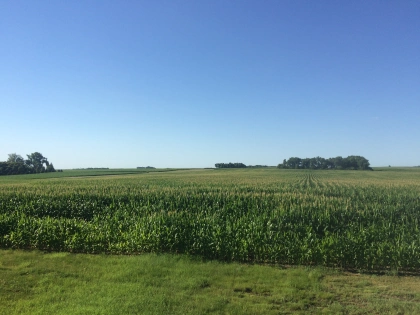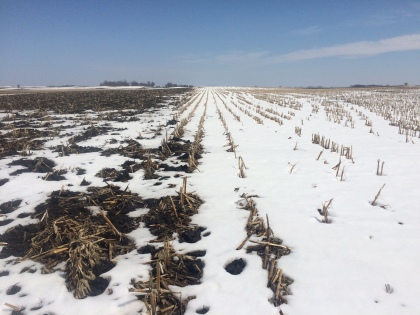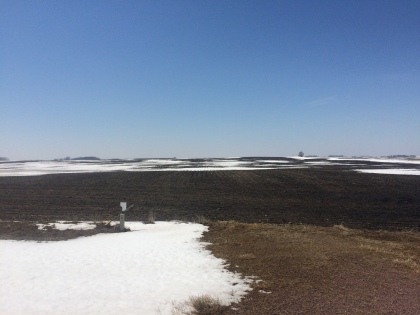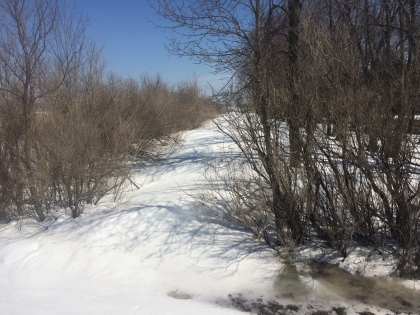Who would have believed it. Here it is July 16 and the corn is almost fully tasseled. We went through a terrible spring, wet ground and late planting made us believe the whole year would be late, and now the corn is tasseling on time, this is great!
Now not every field looks this good. There are drowned out spots, but they do not really take up all that much area. Of more concern are really late planted corn, replanted corn and areas of compaction or nitrogen shortage, all of those can amount to many more acres and much more yield loss than the drowned out will effect. When you look across a field and you see areas where the corn looks a bit yellow and is short, that could be from any of those problems. They will cause a shortage of mature corn at harvest and a reduced yield.
So I’m giving thanks for the places where the corn looks great, but I’m a bit worried for the areas where it does not.
This has been a wild spring! First we had lots of snow that didn’t go away, then we had rain that would not quit.
Normally we want to start planting corn about April 23, but it was still cold and wet then. I did finally get started planting on the 7th of May, but I only got 1 acre planted that day. It wasn’t until the 18th of May that I finally got finished planting corn, a full 8 days later than our usual end of planting date.
I got right at it and started planting soybeans on the 20th of May, but then the skies opened up. The field I started to plant got over 4 inch of rainfall that night, and since it is near a creek, all of our neighbors water ran across that field. It was not until the 5th of June before I could get back into that field.
Several times I tried to get soybean planting going again, but it was not until June first that I finally got another field planted. The first week of June stayed mostly dry and I got all of the soybeans planted, about two weeks later than I wanted, but planted.
Between June 6 and June 11 we got 1.3 inches of rain, then 4 days in a row of no rain. I started to get ready to kill some weeds. Then the skies opened. Between June 16 and June 21 we got 6.8 inches of rain, and we had flooded fields.
It is now June 26, 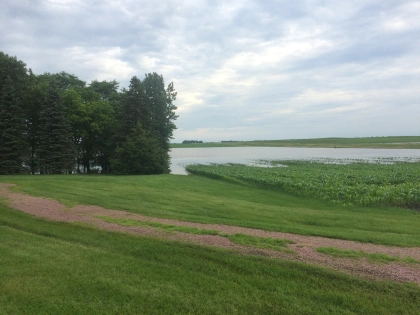 we still have water everywhere. This is north of my dad’s buildings where about 3 feet of water is not going away. We’ll lose crop here.
we still have water everywhere. This is north of my dad’s buildings where about 3 feet of water is not going away. We’ll lose crop here. 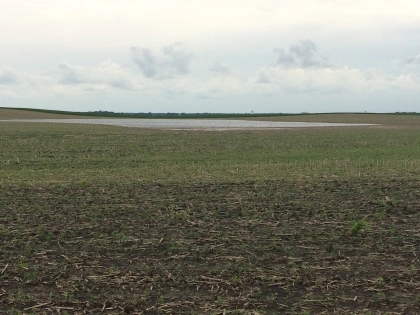 There’s a low spot in this bean field southeast of my house,
There’s a low spot in this bean field southeast of my house,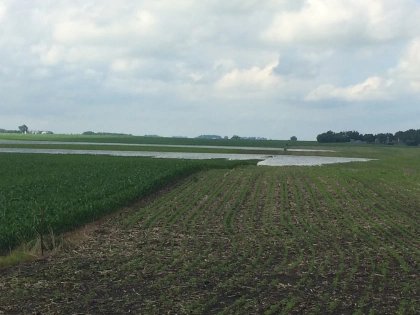 and two ponds in view along my dad’s west fence line.
and two ponds in view along my dad’s west fence line. 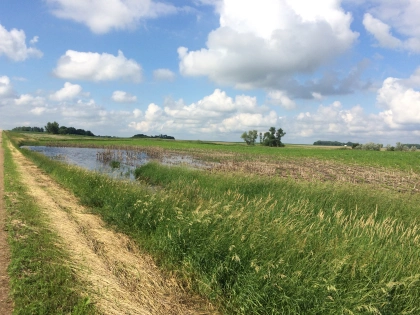 This spot was so wet last fall we could not get it harvested, it still has water in it today. I’m actually amazed that the soybeans look good here since this field got two showers of over 4 inches.
This spot was so wet last fall we could not get it harvested, it still has water in it today. I’m actually amazed that the soybeans look good here since this field got two showers of over 4 inches.
My farm has gotten 9.6 inches of rain so far this month and more is forecast in a day or two. This is definitely a spring for the record books.
Filed under: agriculture, cold, Corn, Farm, farm life, Minnesota, planting, Trees, weather, winter
April 15 was the first day crop insurance covered newly planted corn here in Southwestern Minnesota. Has anyone here started planting corn yet? Not this year! This year we had just received 7 inches of snow on April 14.  In years past some of my neighbors would have planted some of their corn before April 15, not this year!
In years past some of my neighbors would have planted some of their corn before April 15, not this year!
April 22 is the first day that the University of Minnesota recommends planting corn here in Southwestern Minnesota. Will we be planting corn on Monday? Not this year!
This year we still have snow in the fields.
This year a field like this where the snow is mostly melted is hard to find in my neighborhood.
This year a field tree line has a lot of snow on the down wind side where snow piled up when the north winds blew the snow around.
This year groves of trees have 4 feet or more of snow piled up in them which will melt into the fields for a long time yet.
So when do I hope to start planting corn? Who knows. It will not be this month. My hope is to start planting by the normal last day of planting on May 10. If I have to wait to plant corn after May 20 we’ll have to change the varieties of corn I plant. This year may yet go down in the books as the latest I have planted corn, but I do not know the answer to when I will start planting yet, all I can say is not yet.
Filed under: agriculture, Animal care, Corn, Farm, food, Minnesota, Soybeans | Tags: Corn and Soybean growers, Minnesota, Shrimp, Tru-Shrimp
On Monday, I attended our local Corn and Soybean growers meeting. The guest speaker was from a company called Tru-Shrimp. The goal of Tru-Shrimp is to help the U.S. grow more of the shrimp currently eaten here. Currently 80% of the shrimp eaten in the U.S. is grown overseas in lagoons and bays near the ocean. Because of a variety of problems, these shrimp production areas can have a mortality rate of over 60%, a number that no U.S. farmer would allow in their flocks and herds.
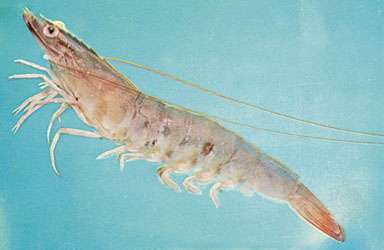
Tru_Shrimp has developed an indoor pond system for shrimp production in Balaton, MN. Thats about as far away from salt water as you can get in the lower 48. This pond system is set to be put into full scale production in an indoor ocean near Luverne, MN in about a year. The plan is to eventually have 12 of these large scale shrimp production sites in the area.
Now why would the corn and soybean growers be interested in shrimp production? The food source for the shrimp will be locally sourced corn and soybeans. In ocean side shrimp farms the shrimp are fed fish meal. Taking fish and fish by-products for shrimp production may be part of the reason for the 60% mortality rate. Using corn and soybeans in a totally enclosed system where water is filtered and reused has gotten the mortality rate to nearer 10%, a truly ground breaking shift.
So keep your eyes open for Tru-Shrimp. Once those Minnesota shrimp farms are up and running you’ll be able to buy and eat some really fresh shrimp, all brought to you by folks here in the Land of 10,000 Lakes, and your Minnesota Corn and Soybean Growers.
It seems that every storm since Christmas has had us in it’s bull’s eye. Many areas to our north have been mostly snowless, but we have been buried in snow. Now comes March and we really get dumped on.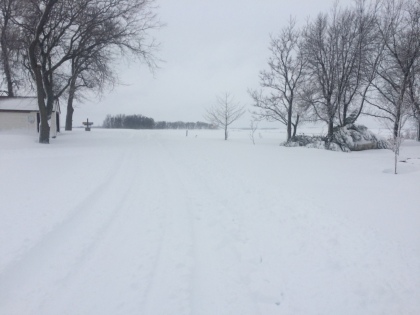
I know we got at least 10 inches of snow to go along with the stuff that had not melted from the past storms.
There was not a lot of blowing, but what there was left some interesting drifts to walk around to get to my snow removal equipment. The snow was heavy and wet, so a blower had a hard time moving it, and some times the snow would not flow into the blower. I ended up pushing some piles up behind my tractor blower.
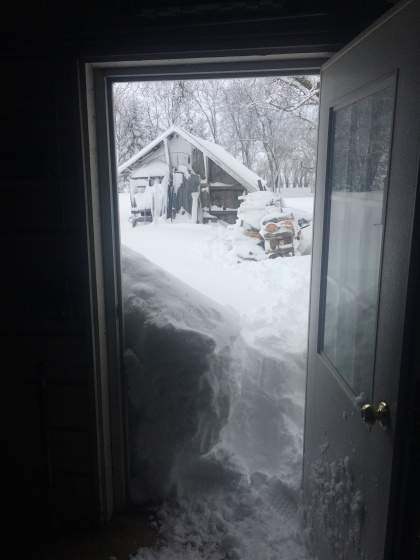
I decided to move the minimal amount of snow I had to. I’m hoping that warm temperatures and rain will move it out, but it is still going to take a long time to melt this snow. As long as we have snow, the temperatures will not warm up, so melting will be slow.
With planting only a month away and Easter later this week, signs of spring are welcome. It’s just that I know we have a lot of melting to do to get to spring.
Filed under: Ag education, agriculture, american farm bureau federation, Farm, Farm Bureau, farm life | Tags: AFBF, american farm bureau federation, Nashville
 This past week I was able to attend the American Farm Bureau Federation’s (AFBF) 99th Annual Convention & IDEAg Trade Show. Part of the reason I go is to participate in educational workshops that help me to expand leadership skills and impact policy discussions. There is the opportunity to celebrate the accomplishments of leaders in agriculture and witness keynote speakers in the general sessions. I get to explore the IDEAg Trade Show floor to gain a stronger industry network, learn about innovative technologies, and enjoy TED-style talks on the Cultivation Center stage.
This past week I was able to attend the American Farm Bureau Federation’s (AFBF) 99th Annual Convention & IDEAg Trade Show. Part of the reason I go is to participate in educational workshops that help me to expand leadership skills and impact policy discussions. There is the opportunity to celebrate the accomplishments of leaders in agriculture and witness keynote speakers in the general sessions. I get to explore the IDEAg Trade Show floor to gain a stronger industry network, learn about innovative technologies, and enjoy TED-style talks on the Cultivation Center stage.
An annual meeting gives you the opportunity to interact with others in agriculture and share your stories of the rural life. There were plenty of opportunities to tour the Nashville area and experience things only available in Music City. I also met up with a few friends from across the country that I only see at a major event like this.
Since the Convention was held in Nashville we were lucky to get Reba McEntire as our Monday keynote speaker, but we also heard from Secretary of Agriculture Sonny Perdue and American Farm Bureau President Zippy Duval plus others.
Sessions I was able to go to included ones on Membership Recruitment, Talking to Consumers, Animal Activism and Religion, Crop Markets, Crop Insurance, Farm Policy, Retirement, and Dicamba.
The last official event of the General Session was an address by President Trump. It has been 25 years since a president has addressed the AFBF, they are always invited, but few take the time. Policy development sessions were scheduled for Tuesday, but not being a delegate we did no stay for that.
Next years 100th AFBF meeting is in New Orleans, a place I have yet to visit. I’m seriously considering making the trip.
Filed under: Farm, Farm Bureau, Politicians, Politics | Tags: 2018 AFBF Annual Convention, Nashville, President Trump
I’m just back from a trip to the American Farm Bureau Federation (AFBF) meeting in Tennessee. I like to go every once in a while, especially when it is a city that I have family near. In this case my sister lives just south of the city.
The main sessions run from Sunday morning until Monday afternoon. There are tours and contests that run before and during, a trade show and on Tuesday a delegates session.
This years registration included an orange arm band for use on Monday. That was the only way you could get in to the room for the closing session. The extra layer was because for the first time in 25 years, a sitting President was going to speak to attendees.
Before we left there was a news release that President Trump would be speaking to the assembly. Until later Sunday no one was told exactly when. Then those with the meeting app were sent a change of schedule for the days meetings, including a security page.
Many meeting times were moved up, or moved to different locations, the trade show closed early and security check points were set up. The ball room was to open at 10:00 for the noon closing session, and the line started forming about 8:00. By the time we got in line at 9:00 the line went almost all the way across the Opryland hotel complex.
The security was not ready until 10:30 and the line movement didn’t reach us until 30 minutes later. The first speaker, Secretary of Agriculture Sonny Purdue, started on time. Once you cleared security you were ushered to your seat, you went where they told you, no exceptions. Your group had better clear security together, or you had to sit apart. We got in at 12:15 and were pleased to get in the door. We were about 3/4 of the way back and off to the side so the cameras were not in our way. The auditorium seats about 5000 people, what with about 500 news people, special guests and a congressional delegation, we were quite a crowd. Extra rooms were ready for a remote feed, but a saw a few empty seats in the back.
Security included toilets and a lunch cart. Your only choice was hot dogs, and a few different varieties of drinks. There were no where near the facilities needed for the group. If you left the secure area you could not be sure you would be let in again. After the closing session and an interview of Reba McEntire, there was a scheduled 45 minute intermission, which went a bit longer, no one rushes the President.
The speech was not overly long. He did spend much of it praising the farmers there for their hard work. He also reminded the delegation that throughout our countries history, farmers have answered the call to build and defend our country. The President knew the areas of the country that turned out to elect him were mostly rural. He told us that our forgotten area of the country was not forgotten anymore.
Overall, my opinion of Trump did not change. He seemed to be on message more than usual, perhaps because he thought he was with a friendly audience. He got 6 standing ovations, but not all of his usual topics were universally well received. He did seem to forget where he was later in his speech when he spoke only to the Tennessee delegation, not the whole Federation.
At the end of his speech Trump signed two Executive Orders to promote the increase of the availability of Broadband Internet access in rural areas. These orders were the product of the Rural Prosperity Task Force which was to deliver it’s findings that day. The report is available at usda.gov/RuralProsperity
It was interesting to be in the room with a sitting president, to go through the security measures and hype of a presidential speech. Secretary of Ag. Purdue and AFBF President Duval seem to think he is doing good things for agriculture, we shall see how this all plays out. I can say I was in the room, and in politics it is better to be sitting at the table in the room, than on the menu.
Filed under: Ag education, agriculture, church, Farm, farm animals, food, garden, Kwazamohkuhle, machines, Ondini circuit, Shetek Conference, South Africa, Tractors, travel | Tags: Kwazamokuhle Diaconal Centre
The Kwazamokuhle Diaconal Centre is home base for us when we visit the Ondini Circuit. It is a cluster of buildings and land near Loskop. As is the case with so many lutheran centers, this area also includes the Phangweni congregation (The largest we know of in the circuit) of the Evangelical Lutheran Church in Southern Africa, a cemetery and a school. Also in this complex is a home and school for handicapped children.
The Centre was at one time a mission outpost of the Lutheran Church. It is obvious that it was once quite an operation, today it is but a shadow of its old self. Cattle and goats roam freely on church land outside the fence, and dogs have drug used diapers out of the garbage pit.
When Apartheid ended the missionaries who ran the center were asked to leave. They left a huge leadership vacuum that has still not been filled. On top of it all, no one really knows how much land the church owns here. Despite it all, they are trying hard to make a go of it.
When we were there this August the gardens sat mostly bare. There had not been enough rain to keep the garden going, and the hookup to the reservoir that was meant to irrigate the gardens had been drawing too much water off so they had been asked to stop. Three and a half years of drought have put a strain on all water supplies. That being said the place was busy.
Ladies are still working making communion wafers and shipping them all over the world. Seamstresses still are making robes and stoles for the pastors, and bead work and basketry are being done in the workshops and in homes. These items are for sale on the premises.
The rooms all over the compound are being rented out. Some small storage areas have been converted to rooms for single African men. Small houses are available for families to live in. A library and study rooms for school children occupies most of one building. Pastor Nkosi is staying in the guest house while his house is being built, two German girls who volunteer at the School for Handicapped children are in the guest house apartment, and then there are the ten of us.
Lazarus, the old Massey tractor was started and a few jobs were done with it, but a leaky fuel pump kept us from working it too hard.
An old tractor powered hammer mill was checked out and deemed ready to make corn meal flour.
The pork project, which was only a dream 3 years ago, is now up and running in the old hog barns. There are also pigs at the school, and Mxolisi has been hired to manage that project. He still has a lot to learn, but we must think back to how our grandfathers raised pigs to understand the level they are at.
Pastor Nkosi is hoping to resurrect a chicken rearing operation that was started and then abandoned after a wind storm damaged the buildings. Because the operation was not guarded, some of the equipment has disappeared, but the bones of the operation are still there.
A new enterprise is in the building stage. Just west of the centre’s compound a Community Centre and Rental Rondavels are being built. For now there are just four rondavels, but more are possible if these work out.
There are plans a brewing, and deeds being done to help keep the activities of the circuit going. The people of the Ondini Circuit are not standing still, they are trying, and we wish them the best.
Filed under: Ag education, agriculture, church, combines, Corn, Farm, farm animals, farm life, food, John Deere, machines, Minnesota, Ondini circuit, planting, science, seasons, Shetek Conference, South Africa, Soybeans, tillage, Tractors, travel, trucks
One of the requests we had made on a previous visit was to spend time with a farmer from South Africa. Some of it is curiosity on our part on how agriculture is done in a larger scale, and the other reason is to get a baseline for what agriculture could be in the Ondini Circuit.
Understand, that this is dryland/irrigated farming on a scale not familiar to us here in southwestern Minnesota. Everywhere we travel in South Africa agriculture is so different. Timber, sugar cane and pineapple are foreign to us. Corn, cattle, hogs, soybeans, barley, wheat and oats we understand.
Our South African farmer host also farms on a different scale than we do. While many in our area farm with only family labor, he has a considerable labor force employed. He, his daughter and son-in-law make up the management team. They have 9 full-time employees and 6 part-time employees. The operation produces white corn, soybeans for seed, black oats for cover crop, pasture and hay, wheat, pumpkins and squash for seed, and cattle to make use of land which can not otherwise be farmed.
Our host grew up speaking German, his daughters married English speakers, and his grandchildren speak Zulu with their friends and in school. Most of his employees are native Zulu speakers.
Keeping employees is one of his hardest tasks. To keep good employees he pays them above normal wages and builds a house for them in town. Employee loyalty is rewarded by advancement as space opens up or need requires.
The 8 row, row crop planter he had in the shed has all of the latest attachments for no-til planting, fertilizing and spraying under GPS guidance. While the size of planter was small by our standards, the availability of labor to keep that planter on the move made it just right for his farm.
The nearly new John Deere tractor in his shed complemented the other smaller and older tractors that populated the farm.
The John Deere combine and sprayer also looked familiar to us.
The truck configuration was different to what we use. We saw very few hopper bottom trucks in our travels, but double trailer and straight truck with a trailer combinations, with steel rather than aluminum frames were everywhere. Road conditions and local road laws are the most likely reason for this difference.
Land does not sit idle in this area of South Africa. When one crop is harvested, the planter is already in the field to plant the next. Irrigated oats keeps cattle graze in peak condition although they do have to add some dried hay to keep the cattle on green grass from getting diarrhea.
Irrigation water for this farm comes from reservoirs sourced in the Drakensberg Mountains. Our host farmer serves on the local water board to help manage that crucial water.
Corn stalks are also used to graze stock cattle when available.
During the summer, when all of the irrigated land is planted to other crops, native grass pastures are used to keep the cattle growing. A feed lot is also on the farm, but it is presently only used for part of the year. That is one place he hopes to make more use of. Right now he only has cattle in the feed lot to meet the Christmas market when local prices are highest.
Most of the cattle he has on hand have bells on them. Although all cattle must be branded to prove ownership, there is the potential for theft. The bells are to help the night guards keep track of cattle movements.
One of our South African church hosts was along for the trip, and was very impressed with all of the science that was needed to farm. That one fact is something that few who do not live on the farm understand. If we are to raise food for the world we must use every bit of science at our disposal. Margins on the farm are razor-thin, to make a profit so we can feed our families and pay our employees is not easy in today’s price environment. That fact is true in South Africa as well as Minnesota.
Filed under: Farm, Ondini circuit, Shetek Conference, South Africa, travel, Wildlife
Weenen Game reserve is a smaller game park (4906 hectares= about 19 sq. mile) located 25 km north-east of Estcourt. Its easy access for us meant an easy day trip to a game park rather than the longer trip to more famous game parks.
The park at Weenen does not contain elephants or lions, but it is well populated with ostrich, zebra, giraffe and bush pig (warthog). They also have rhinos, but we saw none of those. Several types of antelope are also in residence. 
Weenen is a drive yourself game park with some camping, hiking and picnicking spots available. You can easily drive all of the roads in a day, but some of the roads are not meant for vans like we were driving.
I must tell you, that I was one of the drivers on this trip, as such I did not have the opportunity to take wildlife pictures on the road. Also this was my 3rd trip to an African game reserve, so I have plenty of pictures of wildlife.
We stopped for pictures and a picnic lunch at the Bushman River canyon on the southeast edge of the park.
Looking west, down the river we looked into a wilderness that had no roads for tourist access. A truly wild magnificence of African thorn veld. Grass growing between thorny trees and bushes abound. A perfect place for the animals living there.
Looking east, we saw the valley open up into the farms and ranches the readily available water made so easy to irrigate.
As we made our way back to the exit we made a turn onto a one-way road that was not meant for our Hyundai 8 passenger vans. Dale and I carefully navigated the ruts and cuts of a road that was truly magnificent in its views. More than once we turned corners to see a road cut from the side of a cliff. One time we had to remove an obstruction from the road before we could continue, and another hard rock-cut came so close to the doors we could not have opened them.
This is not a game park to visit if you are looking for the most dangerous of African animals, but the views are stunning and animals can often be right on the road in front of you. The location just a short distance off of the N3 make it a convenient place to take a break on travels through the area. Few visit this park, perhaps some day you will.


